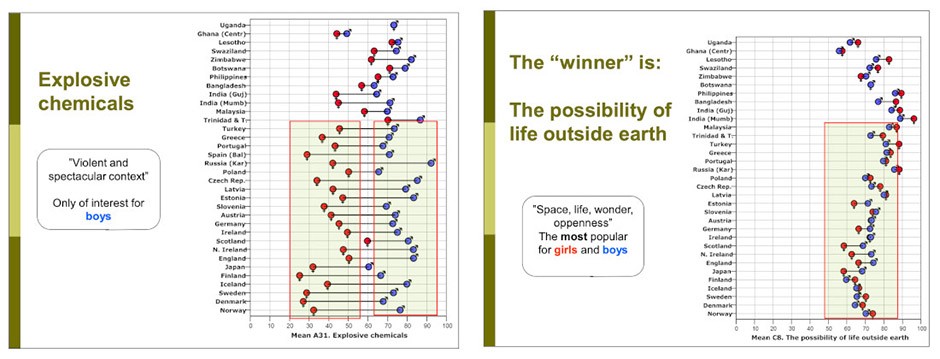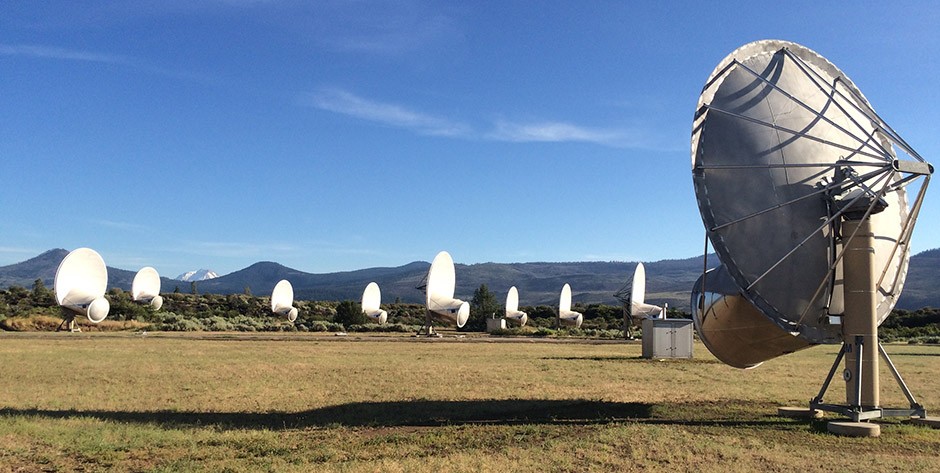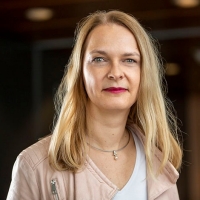Bettina Forget is a doctoral candidate in Art Education. Her research explores the intersection of art and science, and how transdisciplinary education may disrupt gender stereotypes. She owns and directs Visual Voice Gallery, which presents contemporary art that makes a connection to science. She is the Director of the SETI Institute’s Artist-in-Residence Program and VP and Director of Fine Art at the Convergence Initiative. Her creative practice fuses art and astronomy, and her artworks have been exhibited nationally and internationally. Her doctoral research has been funded by the Social Sciences and Humanities Research Council of Canada and a Renata and Michal Hornstein Doctoral Fellowship.
Blog post
Life Beyond Earth: Aliens, Art, and Asking “Big Questions”
 An exoplanet seen from its moon
An exoplanet seen from its moon
Did you get swept up in the recent Mars exploration extravaganza? It’s been a busy February for the Red Planet. NASA’s Perseverance rover has landed at Jezero Crater, and its helicopter Ingenuity is now venturing out to explore the surrounding terrain. The United Arab Emirates has sent its own mission, the Hope orbiter, which is currently studying Mars’ lower atmosphere. China’s Tianwen-1 mission (translated as “Questioning Heaven”) is also in orbit around Mars; its rover is scheduled to land sometime in May or June to investigate the existence of water on planet. Why are we all descending on our celestial next-door neighbour? It may our unquenchable human thirst for exploration and discovery. But, my guess is that there’s a deeper, more existential question that drives our curiosity: the search for life beyond Earth.
 February 2021 Mars orbiters
February 2021 Mars orbiters
The question whether we are alone in the universe is a profound one. As it stands, there’s only a single example of life as we know it: it’s right here on planet Earth. But, how prevalent is life? In his book The Copernicus Complex, cosmologist Caleb Scharf contrasts two opposing theories. On the one hand, the Copernican Principle argues that Earth is quite ordinary, and that our cosmic mediocrity implies that life - both here on Earth and elsewhere - may well be ubiquitous. On the other hand, the Anthropic Principle suggests that our place in the universe is likely unique, since the cosmos seems to be explicitly calibrated to accommodate our existence. While Scharf doesn’t offer a definite answer, he proposes that the evolution of sentient extraterrestrial life is a process that is inevitable, yet rare. What may alien life look like? Evolutionary biologist Wallace Arthur traces the origin and development of life on this planet in his book The Biological Universe. Arthur extrapolates how the evolution of biological life may take place beyond Earth, which, in his view, is likely not that different on an exoplanet than on our own home world. We may all be one big family.
While the philosophical dimension of the question “Is there life beyond Earth?” intrigues me, there is another reason why I’m following this discussion: it is the theme of my PhD research in Art Education. There’s a lovely video on the Public Scholars website that outlines my research, but just to recap: My Ph.D. research investigates how the integration of art and science may create an access ramp for girls into the STEM (Science, Engineering, Technology, and Math) field. Arts integration, in the context of art education, acknowledges the component disciplines while creating a transdisciplinary space that allows new practices and insights to emerge. It creates a more holistic context for learners by focusing on cross-cutting “big questions” that traverse disciplinary boundaries. And what question could be bigger than “Are we alone in the universe?”
 ROSE graphs
ROSE graphs
The search for extraterrestrial life also happens to be the most popular science topic for both girls and boys. The 2019 ROSE (Relevance Of Science Education) Report surveyed school-aged youth from all over the world to ascertain how the science that is taught in schools connects to learners’ lives and interests. The researchers discovered a significant gender gap in the science topics that students wanted to explore. For example, boys were most interested in science lessons that included explosive chemicals, whereas girls were most compelled by the aesthetic aspects of science, such as questions relating to the appearance of colours and patterns in the natural world. However, both boys and girls were equally fascinated by the possibility of life beyond Earth. In fact, it was the most popular topic overall.
 ATA landscape BF
ATA landscape BF
I was delighted to discover this insight in the ROSE Report! Not only is the subject of extraterrestrial life a topic of interest for girls, but it also dovetails with my own creative and professional work. If you’ve read my previous blog post you know that my artistic practice is informed by my activities in amateur astronomy. In addition, my work as the Director of the SETI (Search for Extraterrestrial Intelligence) Institute’s Artist in Residence (AIR) program provides me with an amazing front row seat of the latest cutting-edge research that is taking place in the fields of exoplanet research, Mars analog field work, extremophile research, and space exploration. Whether our scientists are exploring the arid deserts of the Atacama Desert in Chile, plunging into the icy depths of underwater lakes in Antarctica, or listening for alien technosignatures at the Institute’s Allen Telescope Array in Northern California, their motivation is the same: the study of life beyond Earth. Most notable among the researchers is Jill Tarter, one of the early founders of the SETI Institute. She became active in SETI research in the 1970s, when there were very few women working in astronomy. However, the fact that the SETI program was an unconventional, nascent niche of science at that time provided Jill with a bonus. “I was fortunate that gender discrimination didn't play a role as SETI was a fairly new area” she noted in an interview. As it turns out, she was a trend setter. If you browse through the Institute’s directory of scientists today, you’ll notice that women are well represented at the Institute, especially in the fields of exoplanet research and astrobiology.
 Alien Questions
Alien Questions
About ten years ago, Jill Tarter co-founded the SETI Institute’s Artist in Residence (AIR) program, together with Charles Lindsay, our program’s first artist. The AIR program expands on the Institute’s mission to explore and understand the origin, nature, and prevalence of life in the universe. We connect contemporary artists with SETI Institute researchers and facilitate an exchange of ideas. During their two-year tenure with the AIR program, our artists create works that meaningfully and critically reflect on the research that takes place at the Institute. The projects that have come out of the program are amazing and span a wide range of disciplines including installation art, dance, poetry, and music. Why did Jill champion the AIR program a decade ago? I remember her speaking at a panel discussion on the topic of communicating with alien life. She remarked “How can we conceive of something that we can’t yet conceive? How can we think about what we don’t know? Art makes that happen. It connects us through imagination.”
Art can play a vital role in pondering humanity’s most profound questions. Are we alone? What would it mean to discover extraterrestrial life? These questions are too complex to be answered by science alone. We need the input of artists - their perspectives, their questions, and their imagination. We need to get away from our anthropocentric world view and question our assumptions about gender roles, the boundaries of disciplinary fields, and how we produce knowledge. Because in the end, the search for life beyond Earth is, ultimately, a search for ourselves.
About the author


